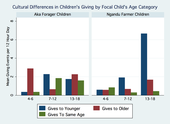Highlight
New Insights on Children's Play and Sharing
Achievement/Results
One of the most consistent social traits differentiating bands of hunter-gatherers from villages of farmers is the very widespread sharing among hunter-gatherers. Researchers have long believed that such sharing was common among our earliest human ancestors.
New data collected by Adam Boyette, Ph.D. candidate in Anthropology at Washington State University-Vancouver, now demonstrate that children in hunter-gatherer bands in the Congo basin of central Africa share more at a younger age than do farming children in the same area. Moreover, hunter-gatherer children are more inclined to share with older individuals than are farming children. As farming children age, they begin to direct their sharing to younger children, whereas hunter-gatherer children direct their sharing more broadly.
Boyette’s spent six months studying two cultures living side-by-side in the Central African Republic: the egalitarian Aka forest foragers, and the Ngandu, a neighboring Bantu farming population with a rigidly hierarchical social structure. This is the first comparative, quantitative analysis of children’s sharing behavior
While his data analysis is still in its preliminary stages, Boyette also found that frequencies of play were very similar in children of the two cultures, with the farmers perhaps playing more. However, the hunter-gatherer children spent significantly more time in exploratory play while the farmer children spent significantly more time in competitive, rule-based games.
These trends closely match ethnographic descriptions of contrasts in these two types of societies. Competitive displays and activities are highly discouraged among hunter-gatherers in general, whereas competition for positions of status are clearly important to success within Ngandu society, where prestige is rewarded rather than avoided. Furthermore, the Aka children spent significantly more time resting, an unanticipated finding which Boyette interprets as related to the autonomy afforded Aka children and their development of social self-regulation.
By contrast, there were no significant differences found between the two cultures in analyses of work or imitation of adult work in play behavior, suggesting that this culture learning for these activities is similar across cultures. Both Aka and Ngandu children engaging in “play work”, supplemented by real work activities as they get older, eventually becoming full members of the work force. In both cultures, girls work more than boys in late childhood, though these differences were greater between girls and boys in Ngandu culture that Aka culture, also paralleling variation in gender-roles in adult Aka and Ngandu culture.
Lastly, sharing is core to hunter-gatherer cultures, and the Aka are no different, sharing widely with no discrimination. Sharing is also important to social relationships among Ngandu farmers, but the manifestation of sharing is very distinct and follows pathways of relatedness and hierarchy. Boyette collected time allocation data on children’s sharing behavior in both the Aka and Ngandu communities.
From preliminary analyses, Boyette found that the frequency of sharing events was very small among children in both cultures, less than 1% of all minute-by-minute observations, but that giving increases with age independent of sex, culture or genetic relatedness. However, Aka children of all ages were significantly more likely to give resources, including food and other material culture, to older individuals. Ngandu children during middle childhood, on the other hand, were significantly more likely to give to other children of the same age than were Aka children.
These results suggest that Aka children increasingly adopt a model of sharing consistent with Aka cultural norms, giving widely independent of the recipient’s age. Since Aka children receive the majority of their food through provisioning from older individuals, for who any resource would have a lower marginal utility because of differences in experience and skill, this result may indicate an important feature of Aka culture learning. Ngandu children seem to learn to follow a model more commensurate with provisioning along with reciprocity with their peer group, as would be predicted for cultures with age and status hierarchies.
Boyette is a trainee in the NSF-funded IGERT Program in Evolutionary Modeling, a joint PhD-training project of Washington State University and the University of Washington. His field research, which will be thoroughly discussed in his dissertation, was also funded by the Wenner-Gren Foundation for Anthropological Research.
Address Goals
Widespread sharing likely discriminates early populations of humans from their common ancestor with the other apes. Understanding how sharing patterns develop in contemporary hunter-gatherer societies may promote insights into the evolutionary processes at work in this earlier transition.
Cultural transmission is the most important mechanism for learning in humans; most of what we know is socially learned rather than individually discovered through trial-and-error processes. The work reported here can be viewed as basic research on how we learn, with possible but unpredictable spinoffs for expanding public scientific literacy.








